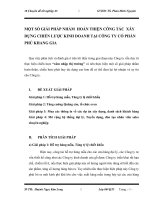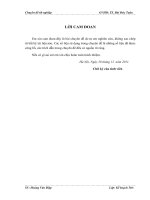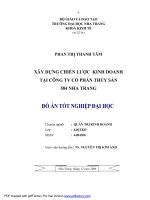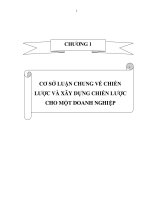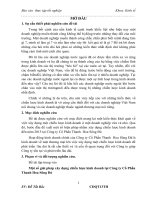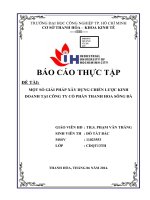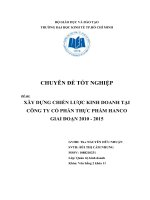LUẬN văn THẠC sĩ xây DỰNG CHIẾN lược KINH DOANH tại CÔNG TY cổ PHẦN QUỐC tế AIC
Bạn đang xem bản rút gọn của tài liệu. Xem và tải ngay bản đầy đủ của tài liệu tại đây (358.97 KB, 81 trang )
LUẬN VĂN THẠC SĨ XÂY DỰNG CHIẾN LƯỢC KINH DOANH TẠI CÔNG TY CỔ
PHẦN QUỐC TẾ AIC
BUILDING BUSINESS STRATEGY FOR ADVANCE
INTERNATIONAL JOINT STOCK COMPANY (AIC)
CONFIRMATION OF ADVANCE INTERNATIONAL JOINT STOCK
COMPANY (AIC)
We, Advance International Joint Stock Company confirm that we the research
group including the members mentioned below to be allowed to get access to the
internal documents, data as well as contact with the operation fact to study about the
strategic orientations of AIC, serving the research purpose of the group to complete the
MBA course:
1. Nguyen Hung Cuong
2. Nguyen Khanh Van
3. Bui Huy Hoang
4. Ho Duc Viet
5. Vu Quang Hoang Anh
Hanoi, November 29, 2011
HEAD OF PROJECT MANAGEMENT
-i-
TABLE OF CONTENTS
Acknowledgements.......................................................................................................i
Table of contents..........................................................................................................ii
List of figure and diagram.........................................................................................iii
INTRODUCTION......................................................................................................iv
1. Reasons for choosing the research topic
2. The goals and scope of the study
3. Study methods
4. Realistic and scientific meanings of the research topic
CHAPTER
I: THEORETICAL FOUNDATION ABOUT
SETTING
UP
BUSINESS STRATEGY..............................................................................................1
1.1. Concept and classification of business strategy...........................................1
1.1.1. Concept of business strategy...................................................................1
1.1.2. Classification of business strategies........................................................2
1.1.2.1. Basing on strategic levels..................................................................2
1.1.2.2. Basing on the scope of the strategies................................................2
1.1.2.3. According to strategic approach........................................................2
1.1.3. Business unit strategies............................................................................3
1.1.3.1. M.Porter’s competitive strategy.........................................................3
1.1.3.2. Competitive strategies for business units according to their market
share...........................................................................................................3
1.1.3.3. Competitive strategies for business units challenging the market....4
1.1.3.4. Strategies for business units preceding the market...........................4
1.2. The steps involved in building business strategies.......................................5
1.2.1. Determine the duties or missions of the enterprise...............................5
1.2.2. Determine business targets......................................................................5
1.2.3. External and internal environment analysis..........................................5
1.2.3.1. External environment analysis..........................................................5
1.2.3.2. Internal environment analysis..........................................................7
1.2.4. Set up business strategies.........................................................................8
1.2.5. Solutions to implement business strategies.............................................8
1.2.6. Implement business strategies.................................................................9
1.3. Analysis tools to set up business strategy....................................................9
1.3.1. Porter’s 5 forces........................................................................................9
1.3.2. External factor evaluation matrix (EFE)..............................................11
1.3.3. Internal factor evaluation (IFE)............................................................12
1.3.4. SWOT matrix.........................................................................................13
1.3.4.1. Internal factors................................................................................14
1.3.4.2. External factors...............................................................................15
1.3.4.3. Strategies from SWOT matrix.........................................................15
1.3.5. Competitive profile matrix....................................................................15
1.3.6. QSPM Matrix.........................................................................................16
CHAPTER II: BUSINESS ENVIRONMENT ANALYSIS OF AIC COMPANY. 18
2.1. Overview of AIC...........................................................................................18
2.1.1. Establishment and development process of AIC JSC .........................18
2.1.2. The company’s medical wastewater treatment system........................20
2.1.3. AIC’s vision, mission and core value....................................................22
2.1.3.1. Vision...............................................................................................22
2.1.3.2. Mission.............................................................................................22
2.1.3.3. Core value........................................................................................23
2.2. Business environment analysis....................................................................23
2.2.1. Macro-environment analysis.................................................................23
2.2.2. Business environment analysis..............................................................26
2.2.3. External factor evaluation matrix (EFE)..............................................30
2.3. Internal environment analysis of AIC Company.......................................32
2.3.1. Internal environment analysis...............................................................32
2.3.2. Internal factor evaluation matrix (IFE)...............................................39
2.4. Competitive profile matrix of AIC..............................................................40
2.5. Suggested strategic alternatives..................................................................41
2.5.1. SWOT matrix.........................................................................................41
2.5.2. QSPM matrix..........................................................................................45
CHAPTER
III:
SELECTING
STRATEGIC
ALTERNATIVES
AND
SOLUTIONS..............................................................................................................52
3.1. Objectives of AIC JSC up to 2016...............................................................52
3.1.1. Bases for developing objectives.............................................................52
3.1.2. Objectives of AIC JSC up to 2016.........................................................53
3.2. Strategy selection of AIC.............................................................................54
3.2.1. Comment.................................................................................................54
3.2.2. Selection..................................................................................................54
3.3. Solutions on strategy implementation.........................................................55
3.3.1. Solutions on finance...............................................................................55
3.3.2. Solutions on human resource................................................................56
3.3.3. Solutions on marketing..........................................................................57
3.3.4. Solution on overall management system...............................................60
3.4. Roadmap for strategy implementation ......................................................61
3.5. Recommendations........................................................................................63
3.5.1. Recommendations to the Government.................................................63
3.5.2. Recommendations to the Ministry of Health.......................................64
CONCLUSION..........................................................................................................65
References................................................................................................................... 66
Appendix..................................................................................................................... 67
LIST OF FIGURE AND DIAGRAM
Order
Figure 1.1
Figure 1.2
Names
PEST model
M.Porter’s 5 forces
Page
6
10
LIST OF TABLES
Order
Table 1.1
Table 1.2
Table 1.3
Table 2.1
Names
External factor evaluation matrix EFE
Internal factor evaluation matrix IFE
SWOT matrix
Comparison of the technology of medical wastewater
Page
12
13
13
28
Table 2.2
Table 2.3
treatment system of AIC with other competitors’
External factor evaluation matrix of AIC
Statistics of the products’ quality of medical wastewater
30
33
Table 2.4
Table 2.5
Table 2.6
business units.
Internal factor evaluation matrix of AIC
Revenue from business activities of AIC
Product quality of come medical wastewater treatment
35
36
37
Table 2.7
Table 2.8
Table 2.9
Table 2.10
Table 2.11
Table 2.12
Table 2.13
Table 3.1
units
Internal Factor Evaluation Matrix (IFE) Matrix of AIC
Competitive profile matrix of AIC
SWOT matrix of AIC
QSPM Matrix O-S strategies
QSPM Matrix T-S strategies
QSPM Matrix O – W strategies
QSPM Matrix T – W strategies
Phases to implement the strategies
39
40
42
45
47
48
50
62
INTRODUCTION
1. Reasons for choosing the research topic:
Economic globalization is the inevitable trend of the world today; it dominates
all economies in the world. Vietnam’s membership of WTO has given many
opportunities and challenges to Vietnam enterprises. Therefore, to stay firmly and
develop well in this cutthroat competitive environment, Vietnam enterprises have to
figure out right directions and business development strategy.
In coming years, Vietnam economy starts to develop steadily and the people’s
incomes increase higher. The process of industrial activities has exhausted the natural
resources, polluted the environment; consequently, the community’s living standards
are degraded. Nowadays, medical wastewater treatment from hospitals is a matter of
great concerns, which is thought to develop together with the economic development.
Besides, this matter is a burning issue and receives a lot of concerns from State,
Ministries and Branches. In the current situation, not only inhabitants, the Government
but also hospitals themselves require a good medical wastewater treatment before
recharging into general treatment systems in order to have no impacts on surrounding
environment. Currently, there are many organizations being in need of being supplied
with medical wastewater treatment system; and also there are many divisions at home
and abroad expecting to meet these demands. Advanced international joint stock
company needs to have strategic orientation in attempt to stand firmly in supplying
market of existing medical wastewater treatment technologies and products and have
further development in the future.
In order to make contribution to the development of Advanced International
joint stock Company, we choose the topic: “Building business strategy of advanced
international joint stock Company (AIC) in the 2012-2016 period.”
2. Target and scope of the research
Target: The target of this topic is have comprehensive evaluation on business
operation actuality of the Company and find out advantages and weaknesses,
opportunities and threats in order to map out business strategy for the Company in the
2012-2016 period.
In terms of the research group, this is a chance to apply learned theories on
strategic management in a specific situation in order to experience by themselves and
improve their knowledge, benefit the current jobs of the author group
Research scope: advanced international joint stock Company is known as a
company operating in various fields such as labor export, real estate investment, fund
management and selling commercial products. However, the research topic only
focuses on the aspect of supplying technological products on medical wastewater
treatment. Topic scope is building the theoretical basis on establishing the most
basically business strategy for a company. Regarding advanced international joint stock
Company (AIC), the topic puts the emphasis on analyzing some basic factors affecting
the establishment of business strategy in order to build appropriate business strategy
for the Company in the 2012-2016 periods about providing medical wastewater
treatment technical products. The topic’s content includes:
Chapter 1: Theoretical basis on building business strategy: This chapter
describes the concept on business strategy and the process of planning a business
strategy.
Chapter 2:
Analysis on business environment of the Company: this part
introduces the birth and development of company and major businesses. Moreover, it
introduces visions, missions and core values of the Company; analyzes external and
internal environment in order to find out opportunities, strengths and weaknesses to
build strategic plans.
Chapter 3: Selecting strategic projects and implementing solutions: this part
describes target of the Company until 2016, the Company’s selection of business
strategies in the 2010-2016 periods. At the same time, it raises solutions to implement
that strategy and some proposals to the Company and the Government.
3. Research method
This project focuses on researching, analyzing all information, secondary data
of most fundamental contents through mass media and directly from internal divisions
of advanced international joint stock Company.
Research and establishment of matrixes on selecting strategies is carried out by
specialized method referring to reference experts’ opinions specializing in products and
business environment situation of medical wastewater treatment in Vietnam in order to
set criteria and evaluation for those criteria. This method is easy to implement but the
disadvantage is that the accuracy of this method is lower than that of real survey
because its results come from subjective opinions of experts. However, this method’s
effectiveness is good enough for building a feasible business strategy.
4. Scientific and practical meaning of research topic
Scientific meaning: In market economy, business strategies play a decisive
role in the success of company. It is not only important to one specific company but
also all companies. In order to survive and develop in the market economy, it is a
priority to have effective business strategy.
There are different approaches to build a business strategy for a company. The
important meaning of this topic is collecting theories from various sources so as to map
out the process of building business strategy basically and it must be easy to
understand and implement.
Practical meaning: Business strategic establishment process is applied to
build business strategy in the field of providing products of health waste water
treatment for advanced international joint stock Company (AIC)- a medium and smallsized company, mainly operating in terms of commerce, providing technological
products on environmental treatment, in the 2012-2016 periods. Therefore, research
and proposal of this business strategy for AIC Company is able to be applied for same
size companies in commercial field.
CHAPTER I: THEORETICAL FOUNDATIONS ABOUT SETTING UP
BUSINESS STRATEGY
1.1. Concept and classification of business strategy:
1.1.1. Concept of business strategy:
“Strategy”, a word of military origin, derives from a Greek word “Strategos”.
According to military theorist Clawzevit, military strategy is the art of commanding in
upper hand position. Strategy is the art of distributing and applying military means to
gain the victory. Today, strategy term is used in many various fields of the society;
especially in economic field. According to Fred R.David, strategy is means to obtain
long-term goals; Johnson and Scholes re-defined the strategy in the conditions of the
environment with a lot of speedy changes: “Strategy is the direction and scope of an
organization over the long-term: which achieves advantages for the organization
through its configuration of resources within a challenging environment, to meet the
needs of markets and to fulfill stakeholders expectations”. Similarly, there are many
more definitions.
In short, strategy is the planning of orientation and ways to obtain the planned
targets.
Business strategy: Bruce Henderson, a strategist cum the founder of Boston
Consulting Groups said that “strategy is a deliberate search for a plan of action that will
develop a business competitive advantage and compound it. However, the difference
between the competitors and you is the foundation of your advantages”. Professor
Alfred Chandler, Harvard University, said: “Business is the determination of the basic,
long-term goals and objectives of an enterprise; and the adoption of courses of action
and the allocation of resources necessary for those goals”.
In today’s competitive environment, it can be said that business strategy is
create competitive advantages for the purpose of obtaining business targets in the best
ways.
- 73 -
1.1.2. Classify business strategies:
1.1.2.1. Basing on strategic levels:
Corporate strategy: Is the overall strategy of the organization aiming at
obtaining its goals.
Business level strategy: Refers to the aggregated strategies of a strategic
business unit in the organization, each strategic business unit will make their efforts to
obtain their goals and the overall of these units will help obtain the goals of the whole
organization.
Functional strategy: This base on the functions of the organization such as
financial strategies, human resource strategy, marketing strategies…
1.1.2.2. Basing on the scope of the strategies:
Generic strategy or so-called the corporate strategy which mentions to the
most important matters that cover the whole of the organization and have long-term
meanings, can possibly decide the life or death of the organization.
Functional strategy: is the secondary strategy such as marketing strategy,
financial strategy, price strategies, distribution strategy…
Generic strategy (or corporate strategy) and functional strategy link closely
together to create a complete business strategy.
1.1.2.3. According to strategic approach:
Concentration strategy: only focuses on key points that have decisive
meanings to the production and business situation of the company but not spreads out
resources
Relative strength-based strategy: The strategic planning thought is base on
the organization’s analysis and comparison of products or services in comparison with
those of its competitors, takes its strength to prop up its business strategy planning.
Creative attach strategy: Business strategy relies on the new exploitation to
gain priority in front of the competitors.
-2-
Liberal strategy: this strategy does not aim at key factors but exploits factors
that surround the key ones.
1.1.3. Business unit strategies
1.1.3.1. M.Porter’s competitive strategy:
Cost leadership: this strategy creates competitive advantages owning to have
lower cost than any other competitors do, which enables either superior profits or a
capacity to offer lower prices.
Differentiation: Being able to offer customers products, services and
Marketing programs that are different to those of anyone else in the market and that
customers' value and will prefer in order to attract the customers.
Focus: Is the combination of low cost and differentiation.
1.1.3.2. Competitive strategies for business units according to their market share.
During the business process, each business unit has its own position in the
market; therefore, each business unit has its own suitable strategies.
Strategy for leading business units in the market: In each business sector,
there is a leading business unit; this unit has the greatest and leading market share
compared with its competitors. To stay firm in this leading position, this unit has to
have its own strategies mainly including:
+ Strategy of extending the total market demands: exploiting the most of the
ability to consume by such methods as looking for new geographical locations, new
customers, developing new tools or encouraging the customers to use the
organization’s products much more, etc.
+ Strategy of market share protection: leading business units always have to
face up with threats from losing their leading positions; therefore, it is necessary for
them to have leading position protection strategies such as location defensive strategy
by constantly checking the market and the competitors, using some solutions as
reorganizing its activities to maintain low cost, perfect services, etc. for the purpose of
-3-
keeping the customers; diversify the products to increase the selections of the
customers or incessantly innovate to increase value-added of the customers, etc.
● Flanking defense strategy: pay attention to protect its weaknesses that are
easily attacked.
● Front defense strategy: attacking the competitors before they attack us. To
implement this strategy, there must be good and qualified staffs who have
ability to observe and understand the competitors
● Counter-attacking defense strategy: When being attacked, it is needed to
counter-attack to maintain our position.
● Mobile defense strategy: always renew and develop new products, new
markets, and diversification, etc. aiming at watching for fluctuations of the
market.
● Shrinking defense strategy: by concentrating resources into our strengths.
+ Market share extension strategy: Leading units in the market always have
advantages to extend their market share by mergers and acquisitions of smaller
competitors, or attacking weak competitors.
1.1.3.3. Competitive strategies for business units challenging the market:
Units ranking the second, the third … positions in the market normally use these
strategies, but these units have strong potentials to possibly attack leading units or
other units to increase their market share. To implement these strategies, it is needed to
determine clear targets, competitors and choose suitable attack strategies such as front
attack strategy, flanking attack strategy, etc.
1.1.3.4. Strategies for business units preceding the market:
They are weak business units that cannot afford to face up with strong units;
therefore, these weak units find ways to avoid or precede strong units. Possibly
selected strategies such as business complete simulation strategy, in which weak units
simulate strong units totally; partly simulation strategy, in which weak units simulate a
part of the strong units; improved simulation strategy, in which the weak units imitate
-4-
and have suitable improvement.
1.2. The steps involved in building business strategies
1.2.1. Determine the missions or duties of the enterprise:
Each enterprise has certain missions or duties; all activities of the enterprise
have to orient to its missions. Therefore, business strategy must derive from
enterprise’s missions; missions are foundations of business strategy and the goals of the
strategy aim at completing the missions of the enterprise.
Therefore, first of all, the formulation of business strategy is determining the
missions or duties of the enterprise.
1.2.2. Determine business goals:
Goals are business results or the targets to which the enterprise will orient; goals
are the first as well as the most important foundations to set up business strategy.
The missions of the enterprise is general, but the goals are concretize the
missions or duties of the enterprise; for instance, the duty of a bank is mobilize the
capital and lend an interest; so its goal is how much it mobilizes and loan and for how
long? The number and the types of customers…
The goals are set up basing on missions or duties of the enterprises and internal
or external factors of the enterprise. The goals or targets must be suitable with both
subjective and objective conditions, which means that it is necessary to consider setting
up and adjusting on the basis of internal and external factors of the enterprise.
1.2.3. Internal and external factor analysis:
All enterprises or business sectors are placed into a certain environment
including subjective factors (internal factors) and objective factors (external factors).
To analyze internal factors and external factors of the enterprise, we can use available
data or data surveyed from internal and external factors of the enterprise.
1.2.3.1. External factor analysis:
External factors are objective ones that have influences on the business and
-5-
production activities of the enterprise including all that have negative and positive
impacts. Positive factors are opportunities for the enterprise such as the increase in
market demands, supporting policies of the Government, macroeconomic regulations
of the State. Negative factors are threats on the enterprise such as the decrease in
market demands; the increase in the number of competitors; the increase in input
material prices.
It can be said that external factor analysis is analyze opportunities and threats of
the enterprise.
To analyze opportunities, we collect all external factors that can bring back
opportunities for the enterprise; then analyze, evaluate these opportunities; at the same
time point out which opportunities are the best and which ones should be made use of
next time.
To analyze threats: we collect all external factor; then analyze and evaluate each
factor’s bad impacts on the business process; at the same time, point out which factors
have worst impacts on the enterprise and which ones need paying attention to next
time.
External factors can be divided into 2 types: macro environment and micro environment.
Figure 1.1. PEST Model
Political
Stability of politics
Labor law
Tax law…
Economic
- Changes of GDP
- Interest rate, inflation
rate.
Social
- Population,
demography
- Income distribution
- Lifestyle
Technological
Development of new
technologies
-6-
Source: Strategic Management, Fred, David
Macro environment: Macro environment has influences on the business
process of the enterprise including such factors as economy, policy, science technology,
etc.
Micro environment: Mainly competitive forces. In market economy, the
enterprise normally faces up with the competition. One effective tool to analyze
competitive forces is M.Porter’s 5 forces model.
1.2.3.2. Internal factor analysis
The internal environmental factors are the subjective factors affecting business
operations of enterprise, including negative and positive factors. The factors having
positive impacts are strong points of enterprises such as qualified and professional
staff, abundant financial resources; strong brand, fame .. The main negative factors are
the weaknesses of the business, such as limited financial resources, less professional
sales staff...
It can be said that analysis of internal environmental factors is analysis of
strengths and weaknesses of the business.
To analyze the strength analysis, we gather all advantageous elements and then
analyze, compare to competitors and assess level of creating business advantages for
your business of each factor; pointing out elements that have most negative impact to
the enterprise; defining factors that need to be corrected right away and which is
followed...
To analyze the weaknesses weakness, we gather all the disadvantageous
elements of business, and then analyze, compare to competitors and assess the adverse
impact level on business process of enterprise of individual factors; at the same time,
pointing out factors that have the most negative impact to the enterprise and identifying
factors that need to be corrected immediately and which is followed.
The basic fields of internal environmental factors:
-7-
Human Resources and Organization: Including factors such as: the quality of
human resources, organization and structure of human resources and policies to
maintain and develop human resources, etc.
Financial resources: including factors such as financial capacity, financial
management, accounting systems, etc.
Managerial capacity: including factors such as quality management capacity,
business management, human resources management, etc.
Marketing and sales: including factors such as research and development
market, distribution systems, after-sales service, marketing campaigns, etc.
1.2.4. Business strategy establishment:
Based on the target of the enterprise, the internal and external situation of
enterprise, we establish a business strategy including the following basic contents:
Identify opportunities and options that can help companies achieve business
objectives set.
Select the enterprise’s target market that helps businesses take advantage of
opportunity in best way.
Select kinds of products and services supplied to the target market.
Develop strategies Marketing mix for product market chosen:
● Product strategy: Specify types and the number of product supplied, quality,
price, size, design and other issues related to products that meet requirements
of target market and can achieve the goal of the business.
● Pricing strategy: Setting the price mechanism in conjunction with payment to
meet customer requirements.
● Distribution Strategy: Organizing the system of distribution channels to bring
products to target market as quickly as possible.
● Marketing Strategy: This is a strategy for branding support, image
enhancement for businesses to attract more customers
-8-
1.2.5. Solutions for business strategy implementation:
It is solutions for human resources, financial resources, business and
management organization...to implement the business strategy set. In other words, it is
the arrangement and layout of corporate resources to successfully implement the
business strategy chosen, such as:
Arrange business structure and organization appropriately
Allocate, maintain and develop human resources
Allocate financial resources
Develop a model of scientific and effective management
1.2.6. Implementation of business strategy:
Strategic management process does not stop when the company has set out the
strategy to pursue. It is required a shift from the strategic intent to the strategic actions.
Once the employees, the board of directors of the enterprise understand the tasks and
understand that they are a part of the business, it will be much easier and consensus in
the implementation of that process will help the company obtain success.
Strategic enforcement is often referred to as action stage of strategic
management. Enforcement means motivating employees and executives to turn the
plan into concrete actions. Three main work of the strategic enforcement is to establish
annual objectives, and policies for the departments, and resource allocation. This phase
is often considered as the most difficult stage in the process of strategic management.
1.3. Analyzing tools to set up business strategies.
1.3.1. Porter’s 5 forces model
According to 5 competitive forces model by M.Porter, the enterprise has to
suffer from 5 competitive forces including: rivalry among existing firms; threats of
new entrants; bargaining power of buyers; bargaining power of suppliers; threats of
substitute products and services (figure 1.3. M.Porter’s five forces model).
Rivalry among existing firms: In the business, there always exist many
-9-
enterprises trading the same types of products; to exist and develop, these enterprises
always find ways to create their own advantages to occupy the positions over their
competitors; therefore, en enterprise always faces up with competitive forces from its
existing competitors.
Pressure from the buyers: The buyers always demand the enterprises to fulfill
their needs for both products and prices; therefore, they always bargain with the
enterprises so as to receive the best products and at lowest prices. Therefore, the
enterprise always suffers from the bargaining power from the buyers.
Pressure from the suppliers: This is input pressure. To run the business, the
enterprise always needs materials, and services from other suppliers. Therefore, they
always suffer from bargaining power pressure of the suppliers.
Threats of new entrants: New entrants are potential one that will soon join the
industry and create competitive forces on the enterprise.
Threats of substitute products and services: These products and services will
change the market demands; therefore, these substitutes will influence on the business
operation of the enterprise.
Figure 1.2. M.Porter’s five forces model
Potential entrants
Threats of new entrants
Industry competitors
Buyers
Suppliers
Bargaining
power of
suppliers
Rivalry among existing firms
Distributors
Bargaining
power of
buyers
Threats of substitute products
and services
- 10 Substitutes
Source: Strategic Management, Fred David
1.3.2. External factor evaluation matrix (EFE)
Internal evaluation factor matrix (IFE) summarizes important strengths and
weaknesses of business departments as well as overall enterprise. IFE matrix is
developed in five steps:
Step 1: Making a list of factors crucial to the competitiveness of enterprises in
an industry (usually from 10 to 20 factors).
Step 2: Assigning a weight from 0.0 (not important) to 1.0 (most important) for
each factor. It should be noted, the weight assigned to the factors show relative
importance of those for the success of the enterprises in industry. Thus, for enterprises
in the industry, the importance of factors listed in step 1 is the same.
Step 3: Assigning a rating from 1 to 4 to each factor (actually point to a wider
range). Marking the biggest weakness when sorting by one, the smallest weakness
when sorting by 2, the minimum strength as classified by 3 and biggest strengths when
sorting by 4. So, this is the point of reflecting competitiveness of each factor in
enterprise against rivals’.
Step 4: Calculating weighted score for each factor by multiplying the weight of
that factor with the corresponding rating.
Step 5: The total weighted score for all factors in the matrix is given by
summing the number of relevant factors of each enterprise. The total score shows that,
this is the absolute competitiveness of enterprises.
Accordingly, if the total weighted scores of all factors to be included in the IFE
matrix are 4, the enterprise’s competitiveness is absolute. If it is between 2.50 and
above, it shall be absolutely competitive on average. In contrast, the total number of
- 11 -
points in the IFE matrix is smaller than 2.50, the absolute competitiveness of
enterprises is lower than average.
Table 1.1. External factor matrix
Rate of
External factors
importance
Classification
(weight)
Importance scores
(weighted scores)
List if external
factors
Total
1.00
Source: Dr. Ngo Kim Thanh, Textbook on Strategic Management,
National Economic University Publishing House.
1.3.3. Internal factor matrix (IFE)
External Factor Evaluation Matrix (EFE) helps us summarize and quantify
influences of environment to enterprise. Similar to the step of analyzing Internal factor
evaluation matrix IFE, in order to analyze EFE we also follow five steps:
Step 1: Making a list of factors crucial to the competitiveness of enterprises in
an industry (usually from 10 to 20 factors).
Step 2: Assigning the a weight from 0.0 (not important) to 1.0 (most important)
for each factor. It should be noted, the weight assigned to the factors show relative
importance of those for the success of the enterprises in industry. Total importance of
factors listed is 1.
Step 3: Assigning a rating from 1 to 4 for each factor (actually point to a wider
range). Mark the biggest weakness when sorting by one, the smallest weakness when
sorting by 2, the minimum strength as classified by 3 and biggest strengths when
sorting by 4. So, this is the point of reflecting the adaption of enterprise to threats and
opportunities from environment.
- 12 -
Step 4: Calculating weighted score for each factor by multiplying the
importance of that factor with the corresponding classification scores.
Step 5: The total weighted score for all factors in the matrix is given by
summing the number of relevant factors of each enterprise.
Accordingly, if the total weighted scores of all factors to be included in the IFE
matrix are 4, the enterprise’s competitiveness is absolute. If it is between 2.50 and
above, it shall be absolutely competitive on average. In contrast, the total number of
points in the IFE matrix is smaller than 2.50, the absolute competitiveness of
enterprises is lower than average.
Table 1.2. Internal factor evaluation matrix (IFE)
Importance rate
Internal factors
Classification
(weighted rate)
Importance score
or weighted score
List internal factors:
- Strengths
- Weaknesses
Total
1.00
Source: Dr. Ngo Kim Thanh, Textbook on Strategic Management,
National Economic University Publishing House.
1.3.4. SWOT matrix
Matrix SWOT is a tool that collects all elements of internal and external factors
of the enterprise and combines these factors into such business strategies as:
Table 1.3. SWOT matrix
Strengths (S)
SWOT matrix
Opportunities (O)
Weaknesses (W)
-
-
-
-
-
SO strategy
WO strategy
-
Using strengths to make Overcoming
-
use of opportunities
- 13 -
by
making
weaknesses
use
of
Threats (T)
ST strategy
opportunities
WT strategy
-
Using strengths to avoid Minimizing
-
threats
weaknesses
and avoid threats
Source: Strategic Management, Griggs University
1.3.4.1. Internal factors:
Internal factors of the enterprise include positive one (strength) or negative one
(weakness) such as financial resources, human resources, geology or technology, etc.
Strength: (S) These factors create advantages for the enterprise such as
qualified human resources, strong business capital sources, advanced technology, wellknown trademarks… To develop the strength, the enterprise has to list all its strengths,
then evaluate whether where the strength or core competence of the enterprise are in.
Core competence is the foundation of adjusting and planning new strategies; this
term implies the proficiency in professional knowledge or skills of the enterprise in its
main businesses; the enterprise has more advantages over its competitors and is highly
evaluated by the buyers. According to David Collis and Cynthia Montgomery, key
value is evaluated in some below factors:
● The competitors find it hard to imitate or copy.
● Advantages in long-term beings.
● Suitable with the enterprise.
● Stability.
● Being actual and outstanding competitive advantages compared with other
competitors.
Weakness (W): Besides strength, the enterprise also has weaknesses. These
weaknesses reduce the competitive ability of the enterprise compared with other
competitors such as backward technologies, weak management, limited capital
source... Like strength, we have to list and evaluate each weakness to consider which
- 14 -
one is the worst and which one causes the worst disadvantages for the enterprise. Since
then, propose ways to remedy.
1.3.4.2. External factors:
External factors are objective ones from external environment of the enterprise
that can cause negative or positive impacts on the enterprise and brings both threats
and opportunities to the enterprise.
Opportunity (O): They are favorable factors from external environment the
enterprise can take advantage of to develop such as increased demand, new policies of
the State, science and technology advance...
Threat (T): They are factors from external environment that can threaten the
development of the enterprise such as: increase in competition, the change in policies
of the State, the fluctuation of material prices...
1.3.4.3. Strategies from SWOT matrix:
Strategies from SWOT matrix are withdrawn from the combination of such
factors as the strengths, the weaknesses, the opportunities and the threats. Proposed
strategic methods:
Strength – Opportunity (O – S): Proving the strengths to make use of
opportunities.
Strength – Threat (T- S): Prove the strengths to avoid threats
Weakness – Opportunity (O – W): Make good weaknesses to take
advantages of opportunities.
Weakness – Threat (T – W): Make good weaknesses to avoid threats.
1.3.5. Competitive profile matrix:
Competitive profile matrix compares an enterprise with its major competitors
based on factors affecting the competitiveness of enterprises in an industry, helping
strategists recognize strengths and weaknesses of an enterprise as well as its
competitors; and determine the competitive advantages of the enterprise and
- 15 -
